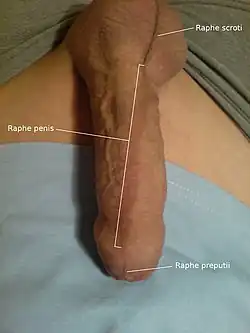Penile raphe
| Penoscrotal raphe | |
|---|---|
 The course of the raphe from the scrotum to the tip of the penis | |
| Details | |
| Precursor | Urogenital folds |
| Identifiers | |
| Latin | raphe penis, raphe scroti |
| Anatomical terminology | |
The penile raphe is a visible line or ridge of tissue that runs on the ventral (urethral) side of the human penis beginning from the base of the shaft and ending in the prepuce.[1][2] The line is typically darker than the rest of the shaft skin, even though its shape and pigmentation may vary greatly among males.[1] The penile raphe is part of a broader line in the male reproductive organs, that runs from the anus through the perineum (perineal raphe) and continues to the scrotum and penis, collectively referred to as median raphe.[3][4] The penoscrotal raphe (penile and scrotal raphe) is homologous to the female labia minora.[5][6][7]
The line consists of a subcutaneous fibrous plate, which may vary in prominence and thickness in various areas of the genitals.[8] In the scrotum, the line is located over the internal scrotal septum that divides the two sides of the sac and is densely occupied by nerve fibers.[9] The raphe may become more prominent and darker when the scrotal sac tightens due to contractions. Behind the scrotum it continues as the perineal raphe. The raphe results as a manifestation of the fusion of the labioscrotal, urogenital and preputial folds during the embryonic development of the male fetus.[8]
See also
References
- 1 2 Fahmy, Mohamed (2017). "Median Genital Raphe Anomalies". Congenital Anomalies of the Penis. pp. 103–114. doi:10.1007/978-3-319-43310-3_16. ISBN 978-3-319-43309-7 – via ResearchGate.
- ↑ Edington, G. H. (1907). "Some Malformations Of The Penis". The British Medical Journal. 2 (2438): 725–729. ISSN 0007-1447. JSTOR 20295897.
- ↑ Mohan, Arvind; Ashton, Laura; Dalal, Milind (2014). "Deviation of the penoscrotal median raphe: Is it a normal finding or within the spectrum of hypospadias?". Indian Journal of Plastic Surgery. 47 (1): 92–94. doi:10.4103/0970-0358.129630. ISSN 0970-0358. PMC 4075225. PMID 24987211.
- ↑ Syed, M. M. Aarif; Amatya, Bibush; Sitaula, Seema (2019). "Median raphe cyst of the penis: a case report and review of the literature". Journal of Medical Case Reports. 13 (1): 214. doi:10.1186/s13256-019-2133-5. ISSN 1752-1947. PMC 6626626. PMID 31301740.
- ↑ Baggish, Micahel S.; Karram, Mickey M. (2020). Atlas of Pelvic Anatomy and Gynecologic Surgery. Elsevier Health Sciences. p. 837. ISBN 978-0-32365-401-2. Retrieved October 28, 2023.
- ↑ Hyde, Janet; DeLamater, John D. (2016). Ebook: Understanding Human Sexuality. McGraw-Hill Education. p. 94. ISBN 978-0-07718-512-1. Retrieved October 28, 2023.
- ↑ Hafez, E.S.; Corriere, J.N.; Lipshultz, L.I. (2012). Sugery of the Male Reproductive Tract. Springer Netherlands. p. 8. ISBN 978-9-40098-849-1. Retrieved October 29, 2023.
- 1 2 Jin, Zhe Wu; Jin, Yu; Li, Xiang Wu; Murakami, Gen; Rodríguez-Vázquez, José Francisco; Wilting, Joerg (2016). "Perineal raphe with special reference to its extension to the anus: a histological study using human fetuses". Anatomy & Cell Biology. 49 (2): 116–124. doi:10.5115/acb.2016.49.2.116. ISSN 2093-3665. PMC 4927426. PMID 27382513.
- ↑ Yucel, S.; Baskin, L. S. (2003). "The neuroanatomy of the human scrotum: surgical ramifications". BJU International. 91 (4): 393–397. doi:10.1046/j.1464-410x.2003.04087.x. ISSN 1464-4096. PMID 12603421. S2CID 29105511.